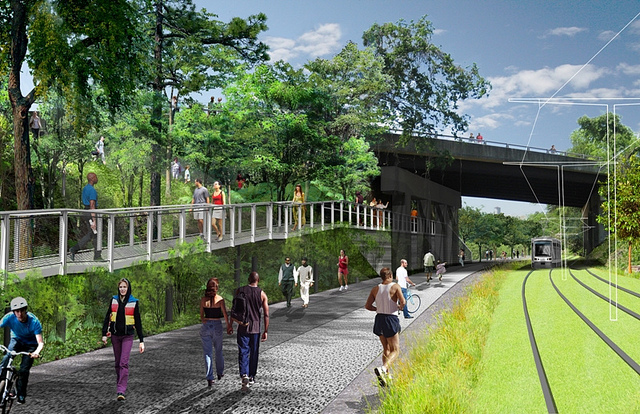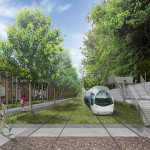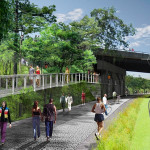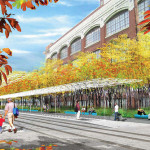This year the American Planning Association (APA) National Conference was held in Atlanta from April 26 to 30 at the Georgia World Conference Center. For those who have never been, it is five days packed full of urban-focused sessions, workshops, tours, meetings, happy hours and an awards ceremony, with approximately 5,000 in conference attendees.
Cincinnati’s Department of Planning & Buildings received the prestigious Daniel Burnham Award for for Plan Cincinnati. Last year in Chicago, Cincinnati took home this same award for the execution of its Central Riverfront Plan. Plus, UrbanCincy was recognized by Planetizen immediately following the five-day event as being one of the “top influencers” at the conference. Needless to say, the mood was especially festive for the few dozen attendees from the Cincinnati region.
Attendees and experts are also able to submit ideas for presentations, and put on a session of their own. For presenters, it is a lot like show and tell. Professionals get to share lessons, valuable knowledge gained on the job or show off a successful or interesting planning project to the world.
This year’s conference program was particularly transportation-heavy, and with good reason.
Many presenters remarked on the increasing evidence that people are trading in their car for a transit pass, a bicycle or walking shoes. Teenagers, in particular, have less interest in acquiring driver’s licenses. The rate at which this is happening is significant enough that it has been covered by nearly every major news source in the United States, according to Greg Hughes from the Utah Transit Authority in a session about transit and competitiveness.
Bloomberg Business Week reported that from 2001 to 2009, 16- to 34-year-olds took 24%more bike trips and were 16% more likely to walk to their destinations. Meanwhile, from 2000 to 2010, the share of 14- to 34-year-olds without drivers’ licenses increased from 21% to 26%.
National Geographic reported in December that this trend was acknowledged in “dramatically altered projections” for transportation energy use over the next 25 years by U.S. government forecasters.
If anyone feels that Cincinnati is bucking the trend, we could take our temperature on the invisible hand.
Zipcar, Uber, Lyft and Cincy Bike Share have all moved past the market analysis phase and are providing, or will soon provide, private-automobile alternatives within the city. In addition, bus ridership in Cincinnati grew by 3.5% last year, significantly more than the 1% seen nationally, according to the American Public Transportation Association.
This same APTA report showed the highest U.S. transit ridership in 57 years. It seems that we could be entering into a new Golden Age of transit.
Atlanta had a few transportation projects of its own to showcase. One of the favorite activities for conference attendees was exploring the Atlanta BeltLine – a 25-year project that will transform old railway and industrial sites into 22 miles of multi-modal trail right in the heart of the city. It connects multiple parks and green spaces, and given that it is woven so seamlessly into the city fabric, is a viable transportation alternative to city streets.
Atlanta boasts the largest public transit system in the southern United States, and carries roughly 500,000 passengers on weekdays.
MARTA rail services were well-used by conference attendees, and some attendees even made a point to get hotels outside of downtown and utilize the subway to get to the conference venue and back. Although not yet operational, Atlanta is also in the process of finalizing its 2.7-mile streetcar project running from Centennial Olympic Park downtown to the historic Old Fourth Ward neighborhood to the east.
Atlanta’s pedestrian-oriented Midtown neighborhood became a favorite after-conference hangout, and the restaurant and pub scene in Little Five Points was both eclectic and funky. Next year’s conference will be held in Seattle.



